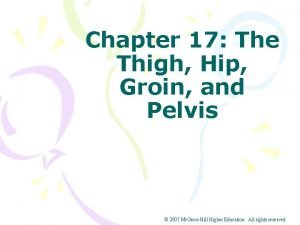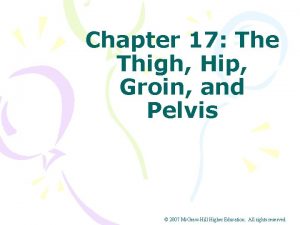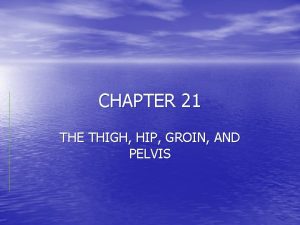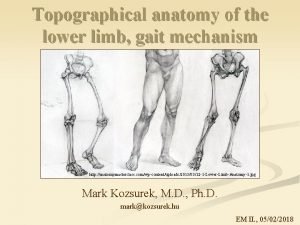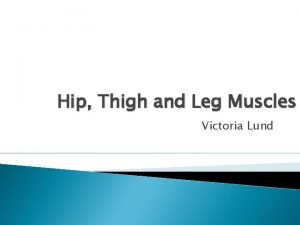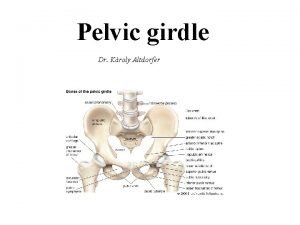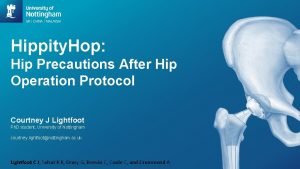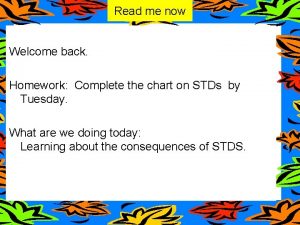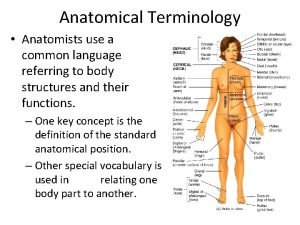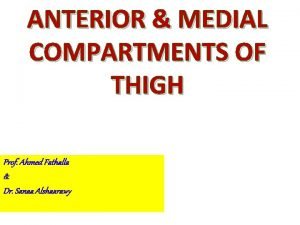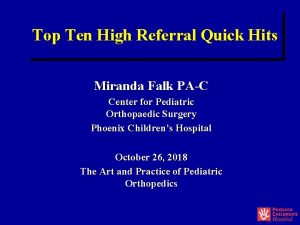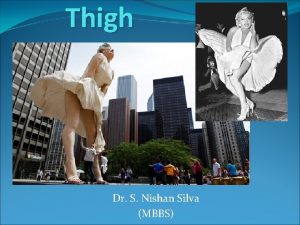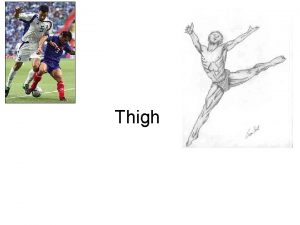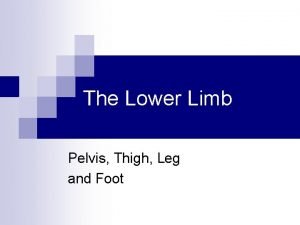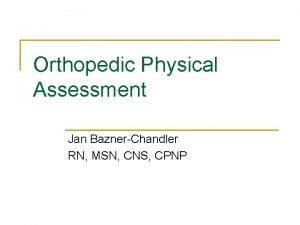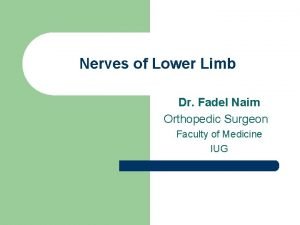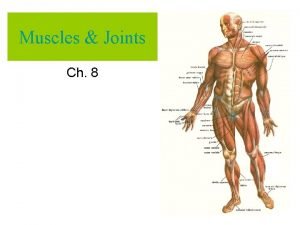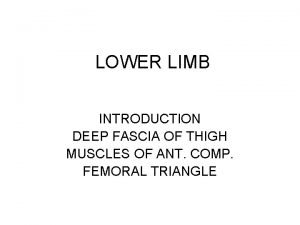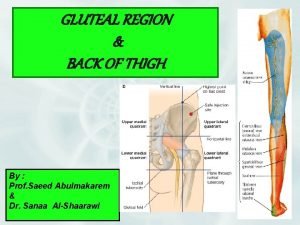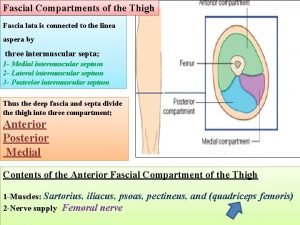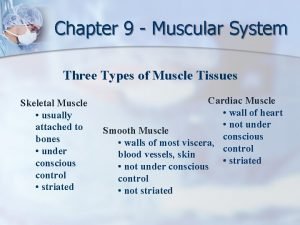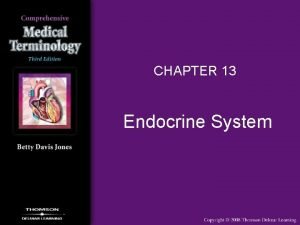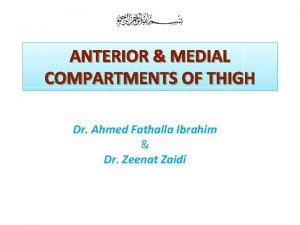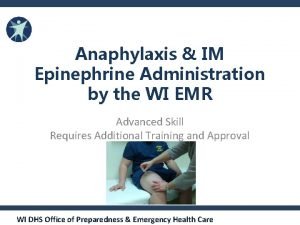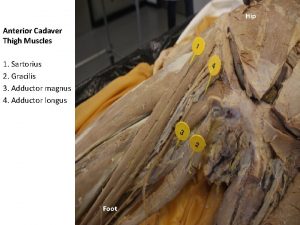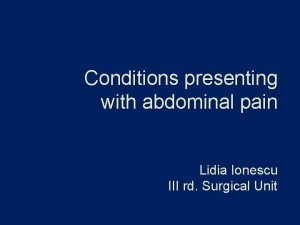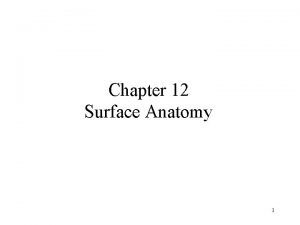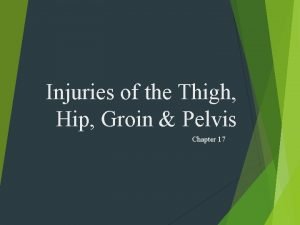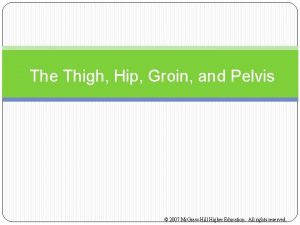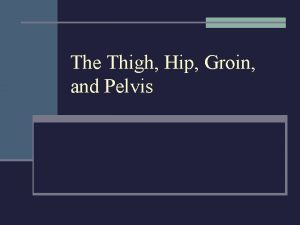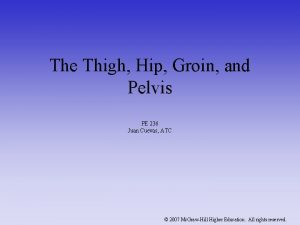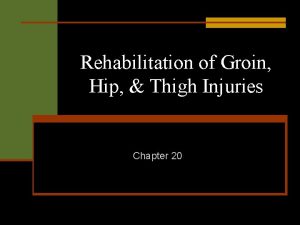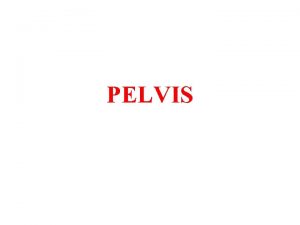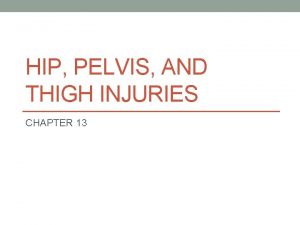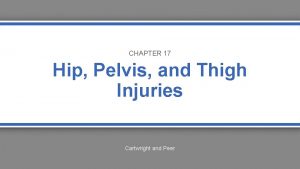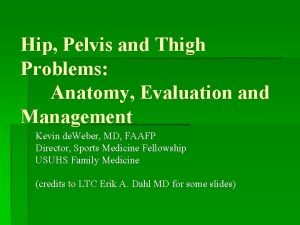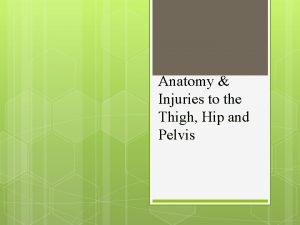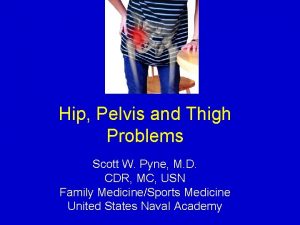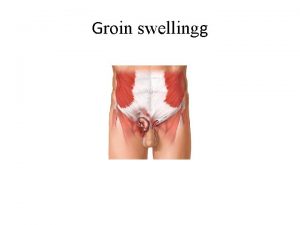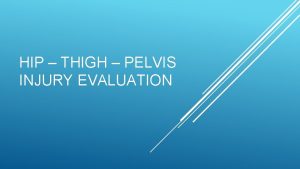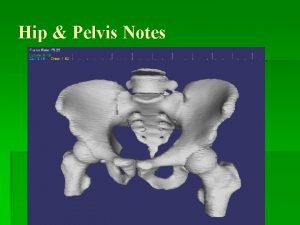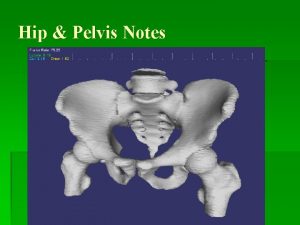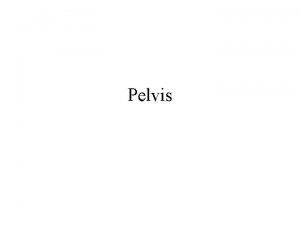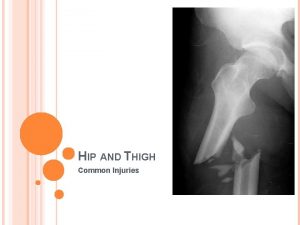Chapter 17 The Thigh Hip Groin and Pelvis

































- Slides: 33

Chapter 17: The Thigh, Hip, Groin, and Pelvis © 2007 Mc. Graw-Hill Higher Education. All rights reserved.

© 2007 Mc. Graw-Hill Higher Education. All rights reserved.

© 2007 Mc. Graw-Hill Higher Education. All rights reserved.

© 2007 Mc. Graw-Hill Higher Education. All rights reserved.

© 2007 Mc. Graw-Hill Higher Education. All rights reserved.

© 2007 Mc. Graw-Hill Higher Education. All rights reserved.

Muscles and Movements • Hip flexion – Normal ROM • 120 degrees knee bent – Iliacus and psoas major (major flexors)_____________ - knee bent – _________ (function when knee is extended and with kicking the ball) – Sartorius • Hip Extension – Normal ROM 10 – 20 degrees – ________________ © 2007 Mc. Graw-Hill Higher Education. All rights reserved.

Muscles and Movements (2) • Abduction – Normal ROM • 45 degrees – ________ • Adduction – Normal ROM • 30 degrees – Adductor magnus, longus, brevis, and gracilis © 2007 Mc. Graw-Hill Higher Education. All rights reserved.

Muscles and Movements (3) • Internal Rotation or Medial Rotation – Normal ROM • 45 degrees – ________________ • External Rotation or Lateral Rotation – Normal ROM • 45 degrees – 6 deep external rotators- piriformis © 2007 Mc. Graw-Hill Higher Education. All rights reserved.

Assessment of the Thigh • History – Onset (sudden or slow? ) – Previous history? – Mechanism of injury? – Pain description, intensity, quality, duration, type and location? • Observation – Postural symmetry? – Size, deformity, swelling, discoloration? – Skin color and texture? – Is athlete in obvious pain? – Is the athlete willing to move thigh? © 2007 Mc. Graw-Hill Higher Education. All rights reserved.

• Palpation – Soft tissue of the thigh (anterior, posterior, medial, lateral) should be palpated for pain and tenderness – Bony palpation should also be performed to locate areas of pain/discomfort – Utilize palpation to assess body symmetry © 2007 Mc. Graw-Hill Higher Education. All rights reserved.

RROM testing • Hip Flexion • Hip Extension • Hip Abduction • Hip Adduction • Hip Internal Rotation • Hip External Rotation • Knee Extension • Knee flexion © 2007 Mc. Graw-Hill Higher Education. All rights reserved.

• Special Tests – Thomas test • Test for hip contractures_______ – Straight Leg Raise • Test for hamstring tightness or • Can also be used to assess sciatic nerve irritation from swelling, bulging/herniated disk or SI joint dysfunction © 2007 Mc. Graw-Hill Higher Education. All rights reserved.

Special Test Cont • Kendall • Pelvic Rock • Trendelenburg’s Test © 2007 Mc. Graw-Hill Higher Education. All rights reserved.

Prevention of Thigh Injuries • Thigh must have maximum strength, endurance, and extensibility to withstand strain • Dynamic stretching programs may aid in muscle preparation for activity • Strengthen programs can also help in preventing injuries – Squats, lunges, leg press – Core strengthening © 2007 Mc. Graw-Hill Higher Education. All rights reserved.

Recognition and Management of Thigh Injuries • Quadriceps Contusions – Cause of Injury • Constantly exposed to traumatic blows – Signs of Injury • Pain, transitory loss of function, immediate bleeding of affected muscles • Early detection and avoidance of internal bleeding are vital – increases recovery rate and prevents muscle scarring © 2007 Mc. Graw-Hill Higher Education. All rights reserved.

• Care – RICE and NSAID’s – ______________ ______________ • Heat, massage and ultrasound to prevent myositis ossificans – Padding may be worn for additional protection upon return to play © 2007 Mc. Graw-Hill Higher Education. All rights reserved.

• Myositis Ossificans – Cause of Injury • _________________ – Signs of Injury • _________________ • Pain, weakness, swelling, decreased ROM • Tissue tension and point tenderness – Care • Treatment must be conservative • May require _________ if too painful and restricts motion • If condition is recurrent it may indicate problem with blood clotting © 2007 Mc. Graw-Hill Higher Education. All rights reserved.

© 2007 Mc. Graw-Hill Higher Education. All rights reserved.

• Quadriceps Muscle Strain – Cause of Injury • __________________ • Associated with weakened or over constricted muscle – Signs of Injury • Peripheral tear causes fewer symptoms than deeper tear • Pain, point tenderness, spasm, loss of function and little discoloration • Complete tear may leave athlete w/ little disability and discomfort but with some deformity; more discoloration; edema will settle in back of knee, calf and ankle – Care – Fit for crutches if necessary • _______________________ • Determine extent of injury early • Neoprene sleeve may provide some added support © 2007 Mc. Graw-Hill Higher Education. All rights reserved.

• Hamstring Muscle Strains – Cause of Injury • Multiple theories of injury – Hamstring and quad contract together – Change in role from hip extender to knee flexor – Fatigue, posture, leg length discrepancy, lack of flexibility, strength imbalances, – Signs of Injury • Muscle belly or point of attachment pain • Capillary hemorrhage, pain, loss of function and possible discoloration • Grade 1 - soreness during movement and point tenderness • Grade 2 - partial tear, identified by sharp snap or tear, severe pain, and loss of function © 2007 Mc. Graw-Hill Higher Education. All rights reserved.

– Signs of Injury (continued) • Grade 3 - Rupturing of tendinous or muscular tissue, involving major hemorrhage and disability, edema, loss of function, ecchymosis, palpable mass or gap – Care • RICE • Restrict activity until soreness has subsided • Ballistic stretching and explosive sprinting should be avoided initially • Fit for crutches if necessary © 2007 Mc. Graw-Hill Higher Education. All rights reserved.

Recognition and Management of Specific Hip, Groin, and Pelvic Injuries • Groin Strain – Cause of Injury • One of the more difficult problems to diagnose • Often seen in early part of season due to poor strength and flexibility • Occurs from running , jumping, twisting w/ hip external rotation or severe stretch – Signs of Injury • Sudden twinge or tearing during active movement • Produce pain, weakness, and internal hemorrhaging © 2007 Mc. Graw-Hill Higher Education. All rights reserved.

• Groin Strain (continued) – Care • _________________ • Determine exact muscle or muscles involved • ____________________________ • Refer to physician if severe groin pain is experienced • Fit for Crutches if necessary © 2007 Mc. Graw-Hill Higher Education. All rights reserved.

• Sprains of the Hip Joint – Cause of Injury • Result of violent twist due to forceful contact • _________________________________ – Signs of Injury • Signs of acute injury and inability to circumduct hip • Pain in hip region, w/ hip rotation increasing pain – Care • X-rays or MRI should be performed to rule out fx • RICE, NSAID’s and analgesics • Depending on severity, crutches may be required • ROM and PRE are delayed until hip is pain free © 2007 Mc. Graw-Hill Higher Education. All rights reserved.

• Piriformis Syndrome – Cause of Condition • __________________ • _________________ – Signs of Injury • Pain, numbness and tingling in butt – may extend below knee and into foot • Pain may increase following periods of sitting, climbing stairs, walking or running – Care • Stretching and massage • NSAID’s may be prescribed • Cessation of aggravating activities will be prescribed • Corticosteroid injection may also be suggested • Surgery is sometimes an option as well © 2007 Mc. Graw-Hill Higher Education. All rights reserved.

Hip Problems in Adolescent Athletes • Legg Calve’-Perthes Disease • Cause of Condition • Avascular necrosis of the femoral head in child ages 4 -10 • Articular cartilage becomes necrotic and flattens – Signs of Condition • Pain in groin that can be referred to the abdomen or knee • Limping is also typical • Varying onsets and may exhibit limited ROM © 2007 Mc. Graw-Hill Higher Education. All rights reserved.

© 2007 Mc. Graw-Hill Higher Education. All rights reserved.

• Legg-Calve’-Perthes Disease (continued) • Care – Bed rest to reduce chance of chronic condition – Brace to avoid direct weight bearing – Early treatment and head may reossify and revascularize • Complication – If not treated early, will result in illshaping and osteoarthritis in later life © 2007 Mc. Graw-Hill Higher Education. All rights reserved.

• Slipped Capital Femoral Epiphysis – Cause of Condition • May be growth hormone related • 25% of cases are seen in both hips • ___________________________________ • __________________ – Signs of Condition • Pain in groin that comes on over weeks or months • Hip and knee pain during passive and active motion; limitations of abduction, flexion, medial rotation and a limp – Management • W/ minor slippage, rest and non-weight bearing may prevent further slippage • Major displacement requires surgery • If undetected or surgery fails severe problems will result © 2007 Mc. Graw-Hill Higher Education. All rights reserved.

© 2007 Mc. Graw-Hill Higher Education. All rights reserved.

• Iliac Crest Contusion (hip pointer) – Cause of Injury • _________________________________ • ______________ – Signs of Injury • Pain, spasm, and transitory paralysis of soft structures • ____________________ – Care • RICE for at least 48 hours, NSAID’s, • Bed rest 1 -2 days in severe cases • Referral must be made, X-ray • Padding should be used upon return to minimize chance of added injury © 2007 Mc. Graw-Hill Higher Education. All rights reserved.

• Avulsion Fractures – Cause of Injury • _________________ • Pulling of tendon away and off of bony insertion • Common sites include ASIS (____), AIIS (__________), ischial tuberosity (______) – Signs of Injury • Sudden localized pain w/ limited movement • Pain, swelling, point tenderness – Care • Rest, limited activity and graduated exercise © 2007 Mc. Graw-Hill Higher Education. All rights reserved.
 Chapter 17 the thigh hip groin and pelvis
Chapter 17 the thigh hip groin and pelvis Chapter 17 the thigh hip groin and pelvis
Chapter 17 the thigh hip groin and pelvis Ball and socket joint
Ball and socket joint Tigh
Tigh Hip and leg muscles
Hip and leg muscles Pectoral and pelvic girdle
Pectoral and pelvic girdle Poem about hip hop
Poem about hip hop Hip hop hip to the hippity
Hip hop hip to the hippity Groin temperature
Groin temperature Lymph nodes in legs
Lymph nodes in legs Groin
Groin Arm anatomical term
Arm anatomical term Groin vault vs rib vault
Groin vault vs rib vault Iliopsoas
Iliopsoas Thigh foot angle
Thigh foot angle Femeral vein
Femeral vein Where is thigh located
Where is thigh located Thigh innervation
Thigh innervation Medline
Medline Ilioinguinal nerve
Ilioinguinal nerve H band muscle
H band muscle Synarthroidal
Synarthroidal Lower extremity muscles
Lower extremity muscles Fascia
Fascia Greater trochanter insertion
Greater trochanter insertion Biceps femoris innervation
Biceps femoris innervation Site:slidetodoc.com
Site:slidetodoc.com Slidetodoc.com
Slidetodoc.com This
This Femoral triangle contents
Femoral triangle contents Dose of epinephrine in anaphylaxis
Dose of epinephrine in anaphylaxis Gracilis cadaver
Gracilis cadaver Psoas sign
Psoas sign Pelvis surface anatomy
Pelvis surface anatomy
